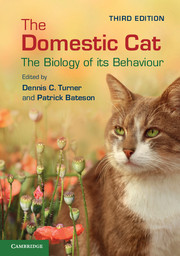Book contents
- Frontmatter
- Contents
- Contributors
- Abbreviations
- I Introduction
- II From Kitten- to Adulthood
- 2 Behavioural development in the cat
- 3 Normal and problematic reproductive behaviour in the domestic cat
- 4 Communication in the domestic cat: within- and between-species
- III Social Life and Ecology
- IV Cats and People
- V Cat Breeding and Cat Welfare
- VI The Future
- References
- Index
3 - Normal and problematic reproductive behaviour in the domestic cat
Published online by Cambridge University Press: 05 December 2013
- Frontmatter
- Contents
- Contributors
- Abbreviations
- I Introduction
- II From Kitten- to Adulthood
- 2 Behavioural development in the cat
- 3 Normal and problematic reproductive behaviour in the domestic cat
- 4 Communication in the domestic cat: within- and between-species
- III Social Life and Ecology
- IV Cats and People
- V Cat Breeding and Cat Welfare
- VI The Future
- References
- Index
Summary
Of all domestic animals, cats are the most capable of breeding, giving birth to offspring and raising their young without human care or intervention. In the classic example, a mother cat that has secretly gone through parturition in some obscure location reveals a litter of perfectly healthy kittens to the human family members after the kittens have been born. This romanticised view of feline motherhood has given way to the more formalised cattery operation, or the family breeder where a mother cat may give birth to her litter of kittens in the midst of an overly concerned family audience.
In this chapter, following some general information about parturition and the care of newborn, normal maternal behaviour is discussed along with comments about problems with various aspects of maternal behaviour. Problems with maternal behaviour manifest themselves primarily as either lack of proper attention to the kittens, resulting in inadequate care and nutrition, or cannibalism of the kittens. Of course, a necessary aspect of reproduction is the mating, which in this chapter is dealt with mostly in the context of intentional mating of females with selected males, in a home or cat-breeding facility.
- Type
- Chapter
- Information
- The Domestic CatThe Biology of its Behaviour, pp. 27 - 36Publisher: Cambridge University PressPrint publication year: 2013
- 2
- Cited by



